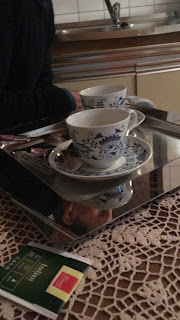Pula
St. Augustine (354-430 AD) once wrote "The world is a book, and those who don't travel only read one page."

Over 400 years before St. Augustine started blogging, the Romans were already traveling (and conquering) the Istrian Peninsula currently part of Croatia, Slovenia and Italy. As we have noted before, Croatia like most of Europe has experienced a revolving door of rulers, but Istria in particular has ping-ponged between Italy and whoever is ruling the rest of Croatia.
We visited the three main cities of the Pennisula; Pula and Rijeka
(part 2) in Croatia and Trieste in Italy.

Pula seemed to make the most of what they have to attract and then entertain tourists. Again, the problem exists in how does a city function and people live when every time you dig a hole you find a Roman artifact or even a Roman?
Need a city hall but there are three Roman Temples (honoring Augustus, Hercules and Diana) in the way? Marry Hercules and Diana to make a city hall, and then leave Augustus (on the left) to ponder.
A contemporary city mixed with ancient ruins. Walk past the parking lot, go towards the dentist's office and find a pristine Roman mosaic in the courtyard of the office, depicting the punishment of Dirce, (appropriate for a dentist's office). http://www.pulainfo.hr/where/floor-mosaic-punishment-dirce
Leave the extra columns and miscellaneous ancient stuff at a playground, more to climb on.


Aggripina's house was in the yard of apartment buildings, behind the bank. Considering she was Caligula's sister, it would be pretty creepy to have her as a neighbor, note- she was not nice, either.
http://www.pulainfo.hr/where/agrippinas-house. A mausoleum is adjacent to a hot dog stand.
Hercules's gate was fronting a restaurant and office building.
A bar above the Amphitheater
The Amphitheater, one of the best structurally intact in the world , so complete that Mussolini wanted to move it to Italy proper during the fascist rule in WW2.

Classic Roman archeological remains just absorbed into the daily life. Google directions: just turn right at the Coliseum, past the Porta Gemina (Twin Gates) on your left and you'll see your destination Jupiter Pizza on your left.
Not satisfied with just antiquities, Pula even turned the port cranes into a tour-book "highlight" light-show.
Another big draw, is James Joyce, who lived in Pula for a year teaching ESL to Austro-Hungarian sailors from 1904-5. He hated it. Despite his feelings for Pula, Pula loved him. He still sits at a cafe, gazing out at lovely buildings and ancient arch in one of the town squares, in front of the building where he taught, which is now a hostel named for him.
Trieste


Following in James Joyce's footsteps we slipped into the (thigh-high) boot of Italy, going to Trieste for the day. Joyce had moved to Trieste from Pula for a much happier, productive 10 years. He again taught ESL, but instead of teaching sailors, he taught to the upper echelon of Trieste society
primarily the sizable wealthy, well established Jewish community including the author Italo Svevo (actual name Ettore Schmitz)
. Joyce created life long connections with the elite, who financially supported him, indulging his artistic whims. They even provided inspiration, it's suggested that Svevo was the model for Leopold Bloom in Ulysses. We visited a very quaint James Joyce/Italo Svevo museum. It was located on the second floor of a government archive library. We were the only visitors in the museum, and got a personal tour by the very attentive curator.
It continued our Joyce world tour as we had previously visited all his museums and landmarks on a family trip to Ireland several years ago.
So we had coffee in Cafe Stella and tried to view his homes but since he moved every few months, due to his penchant for not paying rent, we gave it up as it was a very cold and very windy day.
During Joyce's time Trieste was one of the busiest ports in this part of the world. Trieste has a pretty unique history, not only was it part of Venice for quite awhile, explaining it's piazza that is very similar to Venice's St Mark's Square, but it also was a "free city" that granted full rights to Jews (own land, pursue all occupations, go to university, etc) unlike almost all other European cities of the time. This explained the large, wealthy Jewish community and then later it became the main port of escape to Palestine in the 1930's and 40's. We did peek inside the synagogue, which had been partially destroyed by the fascists in the forties, but now restored and one of the largest in Europe.

Trieste is still a wealthy,
thriving, Italian port city (home of Illy coffee!).
It had Roman ruins, massive Austro-Hungarian buildings and an active port like the other Adriatic coastal cities (of Croatia) but it did feel more economically vibrant and in less disrepair.
So we had a taste of Italy (a slice of Schengen) before catching an early evening bus back to Croatia. Continue on to
part 2, for the third leg of the Istrian Triology.
on to part 2 of the trilogy...

 We arrived at our last stop, Trogir, in a torrential downpour with thunder and lightening (Croatian Callum). It's walled old city was a cramped confusing maze causing us to get lost in search of our airbnb and subsequently drenched.
We arrived at our last stop, Trogir, in a torrential downpour with thunder and lightening (Croatian Callum). It's walled old city was a cramped confusing maze causing us to get lost in search of our airbnb and subsequently drenched.









































































